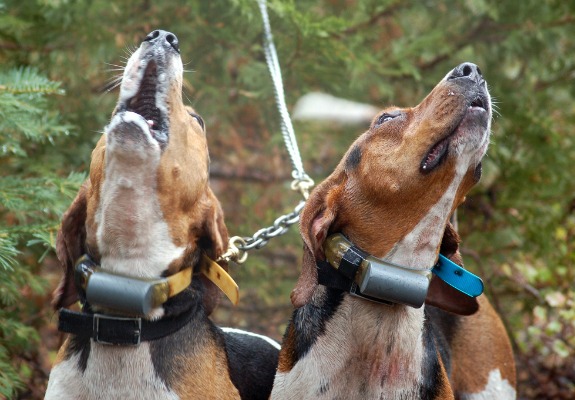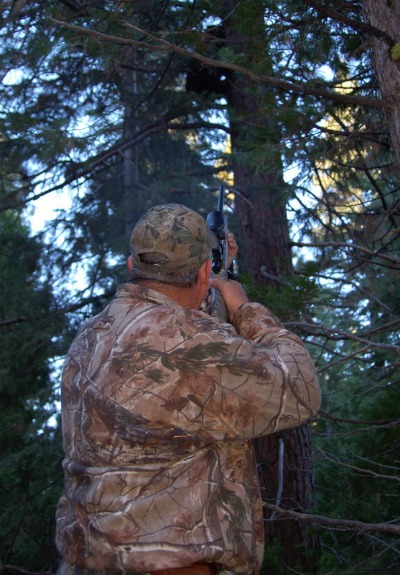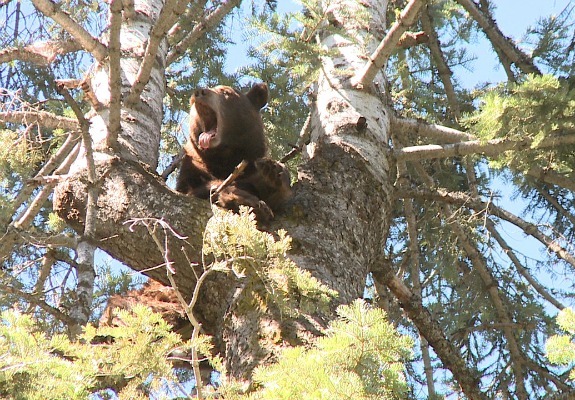Will Hound Hunting in California Be Banned?
Hunters say that the practice brings to life a natural drama between predators. But to many others, the practice is little more than wildlife harassment
This bear has been chased up a tree by a pack of hounds in the California wilderness but appears unconcerned about its predicament. The bear was not shot. Photo by Matt Elyash, California Department of Fish and Game photographer.
Dog versus bear: An ancient duet of nature? Or an artificial battle royale staged by sport hunters?
Advocates and critics each flaunt the opposing characterizations—but either way, hound hunting can be simply defined: the pursuit of a large mammal using a pack of trained dogs that, often, chase the quarry up a tree. Many times, the human hunter, who often locates his dogs by following the signal emitted from their radio collars, shoots the animal out of the branches. Other times, the hunt ends without a gunshot as the houndsman, satisfied only by the chase, leashes his dogs and leads them away, leaving the quarry—very often a black bear, other times a cougar or bobcat—alive in the treetop. Still other times, the pursued animal may fail to make it up a tree and get mauled by the dogs.
This is hound hunting.
In England, foxes have long been the target animal of the sport as highbrow hunters on horseback follow their bawling hounds to the eventual death of the fox. Such hunting has been banned in the United Kingdom, though hunters seem to be thumbing their nose at the law; they continue mounting their steeds and trailing their hounds—”at least as much as ever,” according to one hunter quoted by the The Telegraph. And in America, hound hunting was romanticized in such literature as The Bear, by William Faulkner, and Where the Red Fern Grows, by Wilson Rawls.
But state by state, the practice—call it a sport, a tradition, a hobby, a way of life—is becoming illegal as people sympathetic to the well-being of wild animals campaign to abolish hound hunting. Of the 32 American states that permit black bear hunting, 14—including Montana, Colorado, Oregon, Pennsylvania and Washington—prohibit hunters from using dogs to chase the animals. Now, California could be looking at a statewide ban. Senate Bill 1221, introduced earlier this year by Senator Ted Lieu (D-Torrance), will ban the use of hounds while hunting bears and bobcats if Governor Jerry Brown signs the bill.
The ban would not affect bird hunters who rely on retrievers to recover ducks and other fowl, researchers who hire houndsmen to assist in treeing study animals, and wildlife officials who conduct depredation hunts of bears and mountain lions deemed dangerous to the public or their property.
Hunters are up in arms and have been protesting at public gatherings. Josh Brones is among those leading the defense of the sport. As the president of the California Houndsmen for Conservation, Brones says that hound hunting does not usually involve killing the bear and, what’s more, brings to life an ancient and natural drama between black bears and canine predators. During an interview, Brones said hound hunting is rather like a game of “hike-and-seek.” In these pursuits, the bear leads the hounds through the woods, often for many miles, before climbing a tree. The houndsman, slower but just as dogged as his hounds, eventually arrives, shoots some shaky video of the bear to post on YouTube and finally departs. Hunters sometimes call this activity catch-and-release—and even many wildlife researchers rely on it.
Brones, like many houndsmen, almost never kills bears, he says.
“In my 28 years of hunting with hounds, I have only killed four , and the last one was more than a decade ago,” he said. “I don’t even take a weapon when hunting for bear.”

Fitted with radio collars, these hounds are bawling and ready for the bear hunt. Photo courtesy of Flickr user Cowgirl Jules.
Brones assures that catch-and-release hunting is not stressful to the bear. Though hunting publications frequently characterize bear hunting as the most epic of adrenaline rushes (just Google hunting bears adrenaline rush), Brones says black bears themselves do not experience particularly increased adrenaline levels when chased by dogs. Rather, by fleeing for miles through the woods, bears—as well as other large game—are answering to basic instincts; they are not afraid—just running, he explained to me. He also described treed black bears yawning and nodding off to sleep in the cozy crook of a tree, indifferent to the dogs below. Department of Fish and Game warden Patrick Foy similarly told of treed mountain lions, which are sometimes pursued via hounds by researchers, as appearing “like they don’t have a care in the world.” Foy said, too, that a chase covering several miles of rough terrain is not especially hard on many large wild animals—just a walk in the woods, really.
“For a bear, six miles is nothing,” Foy said.
Some biologists, however, assure that hound hunting has considerable impacts on wildlife. Rick Hopkins, a conservation ecologist in San Jose, California, said in an interview that he participated in a long-term study more than 20 years ago in which he helped catch and radio collar 30 Bay Area mountain lions. In three of the chases, a cougar was caught and viciously attacked by the dogs. He says he knows, too, of cases in which a research hunt led to a cougar kitten getting killed by the hounds.
“Even in research hunts, which are carefully controlled,” dogs catch and maul the quarry, he said. “And I can guarantee that in less controlled hunts, bear cubs get caught.”
Hopkins went on to say, “It’s absolutely silly to suggest that it’s OK to run animals to exhaustion and chase them up a tree, and think that they’re fine.”
To the sport’s many opponents, hound hunting appears like little more than brazen wildlife harassment. Jennifer Fearing, the California director of the Humane Society of the United States, recently told the press, “It’s just reckless wildlife abuse. Even if don’t intend to kill the bear, there isn’t such a thing as benign catch-and-release hound hunting.” Fearing noted that many public parks prohibit unleashed pet dogs.
“And yet we allow this narrow field of people to not only run their dogs off-leash but with the express purpose of chasing wildlife,” she said.
Brones says bears are very rarely injured by dogs, and he says he doesn’t know of any incidents in which cubs were attacked, though this (incredibly graphic, so be forewarned) video shows it happening. While such tooth-and-claw combat may be rare, no one seems really to know how often it occurs. Hunters are regularly separated for lengths of time (that’s why they use radio collars) from their dogs, which may show extreme aggression toward the pursued animal (the dogs often mob dead bears that have been shot from a tree). And for every dog-and-bear fight videoed and posted online, other similar skirmishes likely go unseen or undocumented. In one case described by an official with the Haven Humane Society in a recent letter to Senator Lieu, an injured bear fleeing from hounds happened to enter the city limits of Redding, California, where it climbed a tree. The said official tranquilized the bear, discovered that it bore severe dog bites and euthanized the animal.

A houndsman-hunter takes aim at a black bear. Hunters assure that bears, like this one, are not stressed or bothered when chased into trees. Photo courtesy of Flickr user Cowgirl Jules.
Hounds on the chase almost certainly scare and disturb nontarget wildlife. One European study (Grignolio et al. 2010) found that roe deer, though not the subject of hound hunts, would shift to less desirable habitat during the boar hunting season, where food was less abundant but where regulations precluded hunters and their hounds from entering. And in a July 2006 report (PDF) from the Pennsylvania Game Commission’s Bureau of Wildlife Management, wildlife biologist Mark Ternent wrote, “Pursuit with hounds also may impose stress, disrupt reproduction, and alter foraging effectiveness of bears or other wildlife. Family groups may become separated, or cubs occasionally killed by hounds. However, several studies have concluded that most biological impacts from hound hunting are minimal (Allen 1984, Massopust and Anderson 1984), and the issue of hound hunting is largely social.”
As a species, black bears are not considered threatened. Scientists believe that there are about 30,000 in California, some 300,000 in the United States, and as many as 725,000 across their entire North American range, from Mexico to Alaska. Every year, licensed bear hunters in California take no more than 1,700—a quota set by the Department of Fish and Game. Half or less of these are currently taken with the assistance of dogs—and it’s almost certain that in California, even if houndsmen are soon banned from unleashing their dogs onto a scent trail, the bear hunt will still go on.
The dogs will just have to stay home.
Weigh in in the comment box below: Is hound hunting of bears, bobcats, mountain lions and other animals a fair chase? Or a sport whose time must end?
Planning Your Next Trip?
Explore great travel deals
Smithsonian magazine participates in affiliate link advertising programs. If you purchase an item through these links, we receive a commission.
/https://tf-cmsv2-smithsonianmag-media.s3.amazonaws.com/accounts/headshot/Off-Road-alastair-bland-240.jpg)

/https://tf-cmsv2-smithsonianmag-media.s3.amazonaws.com/accounts/headshot/Off-Road-alastair-bland-240.jpg)